What makes the perfect dropshipping store? It’s a question all budding entrepreneurs should be asking in 2020. Building a dropshipping store on Shopify can promise a golden future; it’s made millionaires out of normal people and there’s no reason why you can’t be one of them.
The dream is simple: passive income for you and your family, giving you the chance to do what you’ve always wanted to do, but is it really as simple as that?
In PageFly’s Dropshipping 101 series, we want to prove that it can be. We’ve already introduced you to dropshipping and shown you how to find dropshipping products and niches, now you’re ready for Chapter 2: How To Build A High Conversion Dropshipping Store on Shopify.
I. How to Find and Work with Dropshipping Suppliers
After you’ve found your product and the market niche you want to target, the next step is to find the base for building your dropshipping store – your trustworthy supplier.
There are a few qualities you’re looking for when it comes to nailing down a supplier:
1.2. Reliable
Like we said, the supplier for your dropshipping project has to be, above all else, reliable. They have to have an established reputation as a reliable business partner and they have to appear to you like they know what they’re doing.
After all, when manufacturing or delivery problems arise with your customer’s order, who’s going to be the one taking the hit?
You can always check their reliability with a quick and easy test. Simply put in a couple of small orders and judge the quality of your package and the speed at which it was delivered. This technique also gives you a glimpse into how the supplier fulfilled their part of the order and whether or not their invoice procedure is up to scratch.

Testing your products is a crucial first step to building your dropshipping store. Image credit
1.2. Legitimate
It goes without saying that your supplier has to be completely above board before you even start working with them, but how can you tell? Well, this actually starts with you. The onus is on you, first of all, to prove your legitimacy as a registered, fully legal business (this comes as standard if operating on Shopify).
Once you’ve done this, it’s their turn. There are some big telltale signs that a company is not legitimate and you’ll want to be on the lookout for these when starting a dropshipping store with Shopify:
- Do they charge a monthly fee for dropshippers?
- Do they operate outside the boundaries of human rights and child labour laws?
- Do they offer the services to the public?
- Do they neglect to provide invoices and guarantees with their practices?
If they’ve fallen flat on any part of this test, you’ll want to steer clear. Of course, only when both parties have proven their legitimacy can this dropshipping relationship blossom.
1.3. Communicative
Throughout your venture you’re going to want to keep in continuous contact with your supplier. Contacting them to find out how you can work together is essential, but doing this also lets you get a glimpse of how invested they are in this budding partnership.
Does the supplier you’re seeking to work with provide you with a dedicated sales rep? Do they respond to emails in a timely manner? Can they be contacted through multiple channels and give you detailed feedback when problems arise?
Naturally, wholesalers are generally sceptical to invest time and resources in unestablished dropshippers, so be patient. Once the trust has been built up, it’s likely that communication between you will improve and you’ll be kept well up-to-date with individual orders and grandiose changes of practice.
| Remember: When looking at how to find a company that dropships, you’ll have to keep in mind that this is a two-way relationship. Prove your willingness, professionalism and efficiency to a supplier and you may find yourself with an undersold product ready to fly off the shelves! |
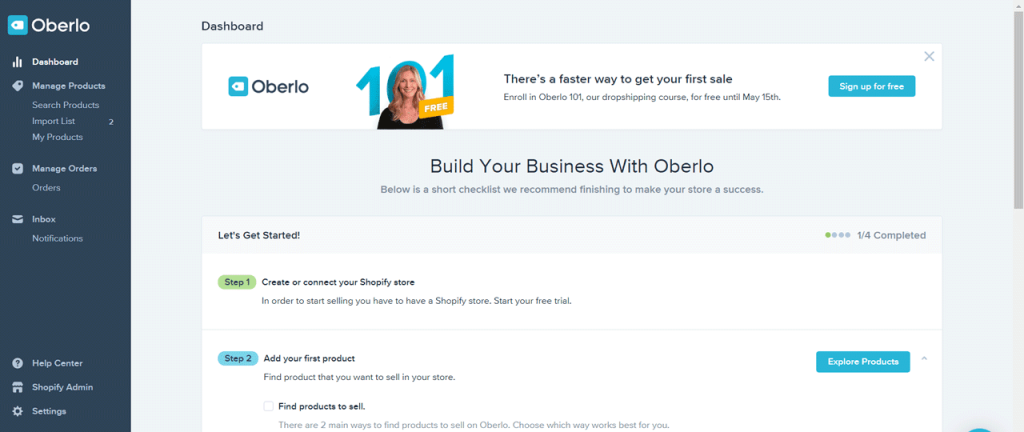
A great resource for finding and communicating with dropshipping suppliers is Oberlo. You can install their dropshipping app directly onto your Shopify store.
Check out this detailed list of Top Dropshipping Suppliers (USA & Worldwide)
II. 10 Essential Steps to Building a Dropshipping Store on Shopify
So you’ve got your product niche, you’ve got your supplier – now you need your store. This is the part of the dropshipping journey that is completely down to you, so we’re going to break down how to build a high converting dropshipping store into the 10 steps you see ahead:
1. Claim your free Shopify trial
One of the best advantages of dropshipping is its ability to keep your overhead low. This also extends to Shopify, which is currently providing all new users with a 14-day free trial to try out its features.
2. Download your dropshipping apps
Shopify is not particularly optimized for hosting drop shippers off its own back. The way to build an effective dropshipping store on Shopify is most certainly with the help of third party apps.
In general, there are a few ways in which a third party app can help you build a Shopify dropshipping store:
- You’ll be looking to keep costs low, especially in the initial stages. Experiment with a few different dropshipping apps by making use of free trials. Almost all apps nowadays have free trials and a few are even free for full use. Of course, these offer limited benefits, but if your first few steps into the world of dropshipping are cautious ones, even the free apps should suffice.
- Much of the dropshipping in the world takes place in the United States, meaning that many dropshipping apps work exclusively with addresses in the U.S. If you’re looking to operate outside of the U.S, you’ll need to find an app that offers its services in Europe, Australia, Asia or beyond.
- One thing you’ll have to be wary of is your preferred dropshipping app’s ability to integrate with a pagebuilder. Shopify’s default page building tools are pretty neolithic, so if you really want your dropshipping app to pop, consider using an external page builder like Pagefly.

There is no shortage of dropshipping apps to try out in the Shopify App Store
So which dropshipping apps to go with? Here’s our quick list of the top 4 you can download on the Shopify App Store:
- Oberlo – For many, Oberlo is the champion of dropshipping apps. It was built exclusively for Shopify and therefore, it’s a marriage that feels as tight as anything. The integration between Oberlo and Shopify is largely automatic and the Oberlo library provides endless dropshipping opportunities for your store.
- Spocket – A huge library with a very easy-to-use interface makes Spocket the preferred app of choice for 30,000 dropshippers. It supports US and EU dropshipping but is a little bit pricier than its main competitor, Oberlo.
- Modalyst – Modalyst is a dependable choice for building a Shopify dropshipping store that targets the US market. It features a good library of niche suppliers that are hard to find elsewhere, but is a little bit limited relative to Oberlo and Spocket.
- Pillow Pockets Fulfillment – PPF is a great example of a dropshipping app that specialises in one particular niche – footwear. There are other apps like this that can do isolated niches better than the big boys; you just have to do some research to see if there’s one for your niche.
Don’t be overwhelmed by the amount of choice in the Shopify App Store; there are a bunch of great dropshipping apps, but just a handful of exceptional ones. The guys over at A Better Lemonade Stand have created a fabulous guide for helping you figure it all out, which you can check out here.
3. Import your Products
Once you’ve got your preferred dropshipping app, it’s time to go shopping! Head straight to their library of products and find ones that fit your niche and ones that your target audience are going to love.
If you’ve done your keyword research properly, then upon downloading the dropshipping app, you’ll know exactly where to start. Type your keywords into the search box and import the products you want to sell in your store.
There are 2 very important factors you need to pay attention to when considering what products to add to your store:
- Imports – The number of times another user using that dropshipping app has imported the product to sell in their store.
- Orders – The number of times that the item has been ordered by a customer via the dropshipping app or the merchant it is linked with (eBay, AliExpress, etc.)
Essentially, these two factors will tell you how much supply there is versus how much demand. You want a low number of imports compared to a high number of orders if you’re building a high converting dropshipping store.
Next, it’s the simple matter of importing them to your store and editing their description, SKU and pricing to suit your desires.

The Oberlo app lets users import products from AliExpress to dropship through Shopify. Here you can see your imported items and alter their characteristics for sale in your store.
4. Building the Perfect Dropshipping Store
You’ve got the merch, now you’ve just got to set up your storefront. Realistically, this step is going to take the longest of all the steps we’ve mentioned here – and with good reason. As a dropship retailer, the vast majority of your job is marketing the merch, for which there’s no better place to start than with a killer website.
Shopify is the best ecommerce platform going, so take your time to get familiar with all of its features. Your website doesn’t have to be super slick and ultra-modern, it just has to be attractive, clear and simple to use.

Life Booster has been successful in dropshipping due in part to the simplicity of its online store.
Once you’ve got your basic design down, consider updating it with a page builder. Shopify is pretty limited in its page building offerings and, as a highly trusted page builder, PageFly knows this only too well. Be sure to check us out in the Shopify App Store to help take your shopfront to the next level.
Generally speaking, there are a few things you’ll want to keep in mind when building a high converting dropshipping store on Shopify:
Is it easy to use?
There are a lot of dropshipping stores out there and if yours isn’t simple enough to use without issues, your customers are going to head straight to another store, sending your bounce rate skyrocketing.
Do you have a great landing page?
As the first thing that most of your visitors will see when coming to your store, the landing page has to be spot on. Check out our guide here for help with this or watch this video tutorial to see how to build a great landing page in under 15 minutes.
Is there any personality in there?
Despite the fact that you’re selling others’ products, not those made by yourself, your page still needs a bit of razzmatazz. Colourful designs and lots of pictures help this – don’t rely too heavily on stock images as they can make a store seem very generic and forgettable.
If you’re looking for some inspiration to get started, you can check out chapter 4 of our Dropshipping 101 series – 50 best dropshipping store examples on Shopify.
Same as Rome, a perfect dropshipping store won’t be built in one day, or even one month.
It takes determination and hard work to perfect every aspect: a mesmerizing website design, quality content, established credibility, you name it.
To make things easier, we have a guide to help you maximize your success for your Dropshipping Store, check it out: Conversion Rate Best Practices For Your Online Store
Want to learn from the best? Check out this video guide where we will walk you through the top 9 best dropshipping store examples and dissect them in-depth to learn how they do things so that you can use them as a blueprint for your own dropshipping store
5. Optimize for Mobile
We’re living in an age where phones are becoming the clear kings of devices. In the realms of ecommerce, this has huge ramifications for your business. Next year, mobile is expected to account for 54% of sales; simply put, if your store’s not mobile-ready, you can kiss that high conversion rate goodbye.
Luckily, building a high conversion dropshipping store for mobile is easy with Shopify, and even more of a breeze with PageFly. Our simple drag and drop system is ideal for optimising your store for the next generation of ‘m-commerce’ buyers.
Check out these tips on how to make your site mobile-friendly.

PageFly’s mobile optimization lets you tap into the future market of e-commerce shoppers
6. Setting up payments and dealing with customers
In dropshipping, dealing with the shipping itself is a split responsibility between you and your supplier. While the supplier is the one who sets the rates and sends out the packages, it’s down to you to deal with the customer service, provide tracking and establish how you want to deal with the costs.
With the latter of these, you have a few options:
- Openly pass on the shipping costs onto the customer.
- Offer free shipping to customers while paying for all shipping costs yourself.
- Offer free shipping and raise the prices of all products to cover it.
Your selection of one of these 3 methods depends on the products you’re selling and the regions you’re selling in. Remember, building a high converting dropshipping store is not all about the look and feel of the website, it’s also what you offer in terms of value to the customer.
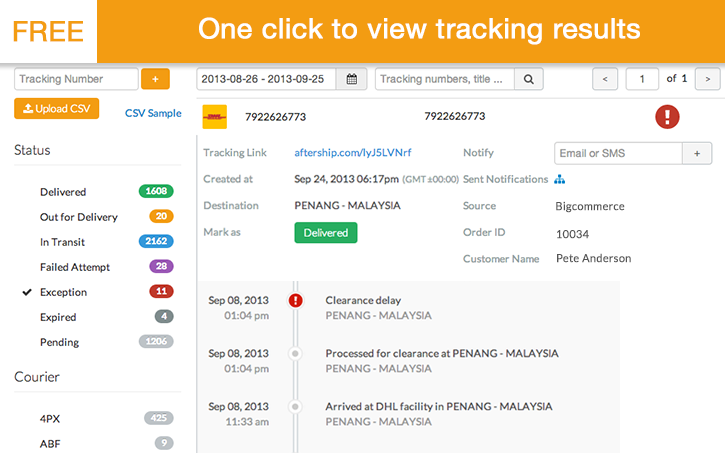
The Aftership app is a great way to track packages that your supplier has sent out. You can get it from the Shopify App Store. Image credit
For tracking, there are several Shopify apps that offer a fantastic service. One of the best is Aftership, which helps you keep tabs on packages as they’re on their way to a customer.
For the customer’s benefit, it’s worth providing them with a link to 17TRACK, which helps them track their package using the numbers provided on their invoice.
In customer service, this is really where you have a chance to make a name for yourself. Problems will occur along your dropshipping journey and it’s vital that you’re there for your customer when they do.
To this end, you might want to elicit the help of a few more Shopify apps from the App Store. Support apps are hugely varied in terms of what they offer, be it live chat support, an FAQ page or a full help centre.
7. Get Advertising
If your store feels like it’s ready to accept visitors, it’s time to reel them in. As we mentioned earlier, advertising is an absolutely essential role for you as a dropshipping entrepreneur – it’s your job to get information out about the product to the people who you think want to see it.
We all know that dropshipping is a low-risk adventure, but advertising is where the biggest risk is. It’s where the majority of your budget is going to go, so you better get to know the ins and outs.
Obviously, this is a huge topic, so we’re not going to dive too deeply into the world of digital advertising, we’ll just give you a few golden pointers:
- Know your audience – Based on your own research, you should know what kind of customer you’re targeting. Think about their age, lifestyles, background, necessities, desires and incomes. Most importantly – where do they spend their time online?
- Go where they go – If it turns out they’re spending hours a day on Instagram, research how to advertise there. If they’re looking for neat little ideas on Pinterest, try there. Twitter, LinkedIn, Snapchat and TikTok can all be incredible places to showcase your stuff, providing that’s where your audience is.
- Start with discounts – Nothing launches a high conversion dropshipping store like a sale. Setting up discount codes for visitors to your store increases traffic and conversion rate immensely, but it also increases your reputation through word of mouth.
- Run Facebook ads – In the vast majority of cases, your customers will be spending most of their time on Facebook (who isn’t?) Consider Facebook ads as part of your marketing strategy, it’s potentially the most efficient platform for fostering a following.
- Create social media accounts across your platforms – Customers themselves are the best advertisers nowadays. If they share a good experience of shopping with you online, chances are that their friends and family are 5 times more likely to make a purchase with you themselves, compared to if you had advertised to them as a brand. A strong network of social media accounts for your business, as well as the availability of social media sharing buttons on your site, gives your products a good chance of getting shared.

Social media plugins have been essential to building high traffic dropshipping stores in recent years. Image credit.
Free Facebook & Google Ads Account Audit
Get your ad accounts audited & find the opportunities you’ve missed out on with actionable tips from certified PPC experts.
Improve ROAS, CPC, CTR & increase sales with an easy-to-implement, step-by-step guide made JUST for your store.
8. Create some blogs
If you’re new to the whole blogging scene, here’s a stat that might pique your interest in the format. According to the guys over at Quicksprout, 70% of people find out about businesses through blogs, as opposed to traditional advertisement, while 61% of people are more likely to make a purchase at your store based on a blog post.
Crazy numbers, I’m sure you’ll agree. Well, this is the reason why blogging has exploded into prominence across the internet. No matter what you’re selling or what service you’re providing – blogs drive traffic to your site.
If you’re working on a low budget, you can consider writing these blogs yourself. You don’t have to be the world’s next Walt Whitman, you just need to know your audience and get to grips with some of the essentials of blog writing:
- Research thoroughly what you’re writing about.
- Write for your audience, not your company.
- Include keywords so that people can find your blog on Google.
If you’re in a position to spend some money, this is maybe where you want to spend it. Remember, blogs are one of the most powerful forms of advertising around right now. Just ask Mike Rothman of fatherly.com, the parenting blog for fathers that went from foundation to $5 million in just 2 years.
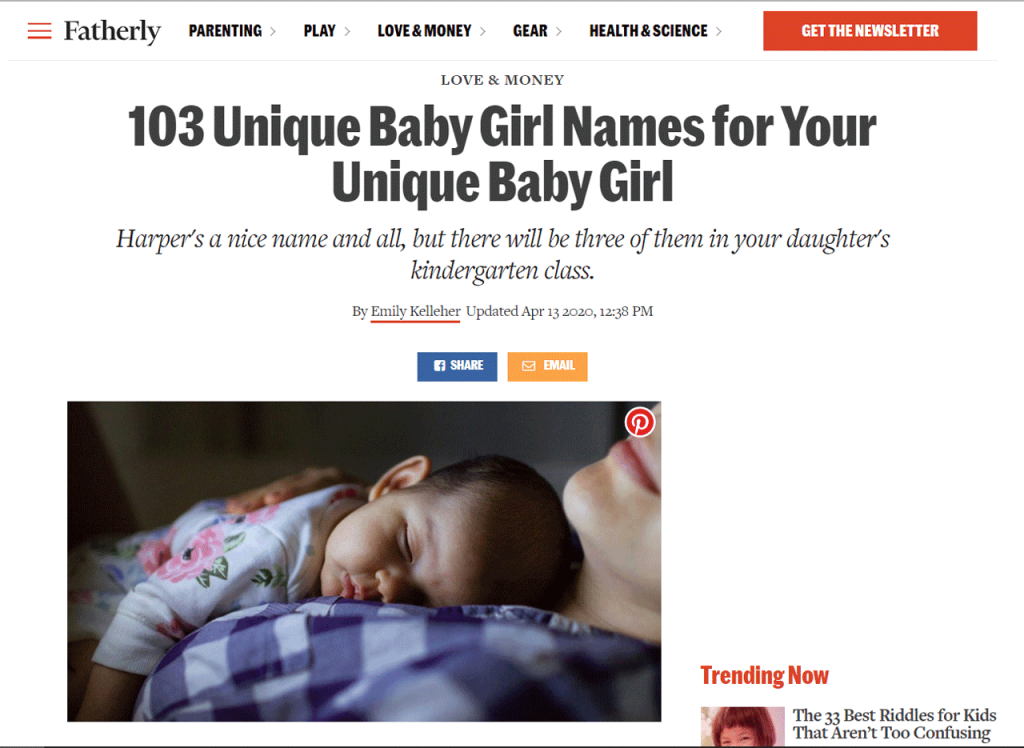
Fatherly has become incredibly successful through its blogging strategy.
| Many one-man-bands have created high conversion Shopify dropshipping stores off the back of blogs that address a market niche. |
9. Create a domain name
When you sign up to Shopify, you’ll be given a default .myshopify.com domain name, but that doesn’t scream ‘personality’ or ‘success’. Get yourself a nice, clean domain name that’s easy to share, helps your site’s SEO and captures the essence of the items you’ll be dropshipping.
This step is super simple. You can get a domain name with Google, or any other hosting service, including Shopify, for a minimal fee. Link it with your website and sit back, proud in the knowledge of owning something that’s exclusively yours!
10. Make a ‘coming soon’ page
Not quite finished building your dropshipping store on Shopify yet? That’s totally fine – these things take a long time to get right. If you want to postpone your site’s opening and build the hype at the same time, get yourself a ‘coming soon’ page.

The Ux ‘coming soon’ page, complete with hype-building timer.
These types of pages let you add a timer and collect contact information from your leads. They also help to get your site live earlier, which gets it indexed by Google more quickly and gives you a bigger chance of getting spotted online.
For help on setting up a ‘coming soon’ page, check out our full guide here.
II. Common Mistakes to Avoid when Building a Dropshipping Store on Shopify
You’ve definitely heard the loud and obnoxious claims of success that dropshipping can bring, but how many times have you heard about the failures? So many people are building Shopify dropshipping stores nowadays, but their lack of preparation means that they make the same mistakes.
These are some of the most common errors that newbie dropshippers make when they’re making their site:
2.1. Not doing market research
What’s really going to make your dropshipping store stand out from the crowd? Is it bold colours? Bold lettering? Bold claims? Or is it, actually, the fact that the products you’re selling are unique and the audience to which you’re selling them actually want them?
If you’ve read the 2nd chapter of our Dropshipping 101 series, you’ll know that finding a great product niche is crucial to high traffic and high conversion. If you’re offering to sell gym wear, what’s different with your gym wear store compared to the thousands of other dropshipping stores selling gym wear? What is the precise niche that your product fills?
Likewise, if you’re selling medieval catapults for war reenactments (now THAT’S niche), are you sure there’s a market for it? A great way to check is with Google Trends, which can show you what your target location has been searching for as well as its popularity trends reaching back.
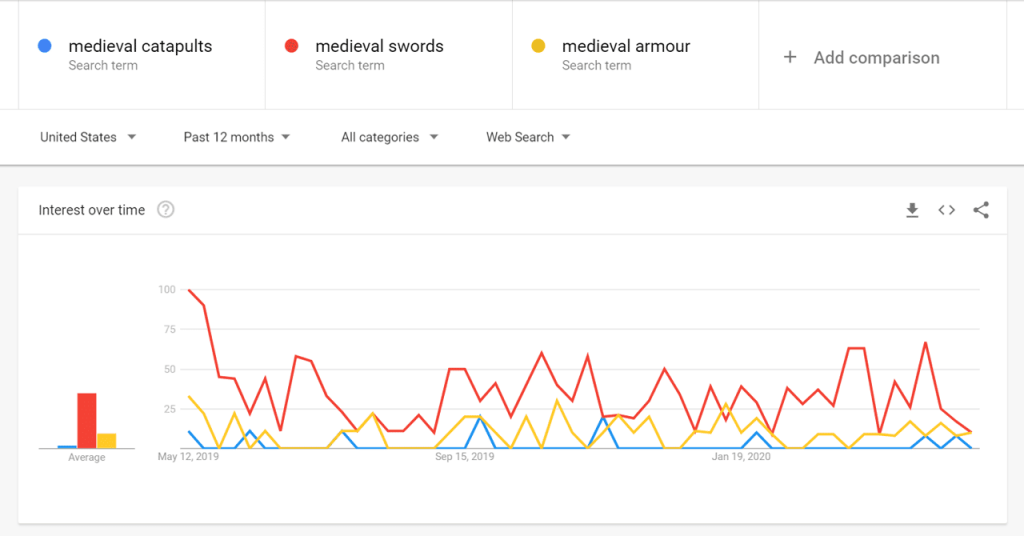
Google Trends comparing the popularity trends of 3 different product niches.
2.2. Not spending any money
As great as the dropshipping model is for its low-risk nature, it’s not no-risk. The people who think it is are the ones who spend next to nothing in order to get their venture off the ground. That’s nothing on research, nothing on web design, nothing on external apps and nothing on advertising.
You know the well-beaten adage, you have to spend money to make money. Generally speaking, there is no guideline on how much money it’s going to take to build a high converting dropshipping store, but we can tell you for sure that it’s more than $0.
This is what we think it’s best to shell out on in order to get your dropshipping business pulling in the customers:
- Advertising – Whether it’s blogs, Facebook ads or getting Instagram influencers to credit your products, advertising should certainly take the largest chunk out of your dropshipping budget.
- Initial tests – To find the perfect product, you’ll have to do a few tests to ensure that your supplier’s got everything down in terms of product quality, service and logistics.
- Shopify apps – These certainly don’t have to break the bank, but between dropshipping apps, currency converters, tracking apps, page builders, product options apps, social media apps and more, you’ll have to be willing to spend a bit.

The pricing plan for the Social Media Stream app. Costs like these can build up quickly.
Still, in comparison to many other business ventures, building a dropshipping store on Shopify is super low-cost. You’ll probably read plenty of stories where high traffic shops have been built on less than $500.
2.3. Not sticking to the theme
It’s too easy to become like a kid in a toy shop when you first lay eyes on a dropshipping app like Oberlo. There are so many great things to sell from huge online databases, all addable to your store with the spontaneous click of a button.
This is one of the reasons why some dropshipping stores fail – not sticking to a central product niche and confusing their customers with no sense of identity.
Say you’re looking for artisanal Japanese apparel, you might come across a store like Kusoka. You’ll find only exactly what they advertise here – no unrelated items that don’t fit the central identity of their store.

Kusoka sells Japanese clothing and Japanese clothing only.
That’s not to say you can’t sell add-ons and little trinkets related to your main idea, but you need to make sure that these are products that your customers might also consider. So, you want a new pair of gym shorts? Fair enough. Do you want a make-up kit to go with it? Probably not.
2.4. Rushing to success
Another overused adage to tell you something you probably already know: Rome wasn’t built in a day. Likewise, learning how to build a high converting dropshipping store – and then actually building one and advertising it – takes a lot of time.
Many people get blinded by the stories of rapid success in dropshipping and neglect the reality of it. The truth is that you can find quick success as a dropshipper and turn a profit in the first month, but you need to know exactly what you’re doing.
The vast majority of dropshippers are budding entrepreneurs who are still learning the ropes. Don’t see it as a get-rich-quick scheme, see it as a long-term plan to secure future income.
III. Top 03 Examples of how to Build the Perfect Shopify Dropshipping Store
There’s no denying that the times when dropshipping can go right, it can go very right. Here are 3 examples of the best Shopify dropshipping stores:
3.1. Oddity Mall
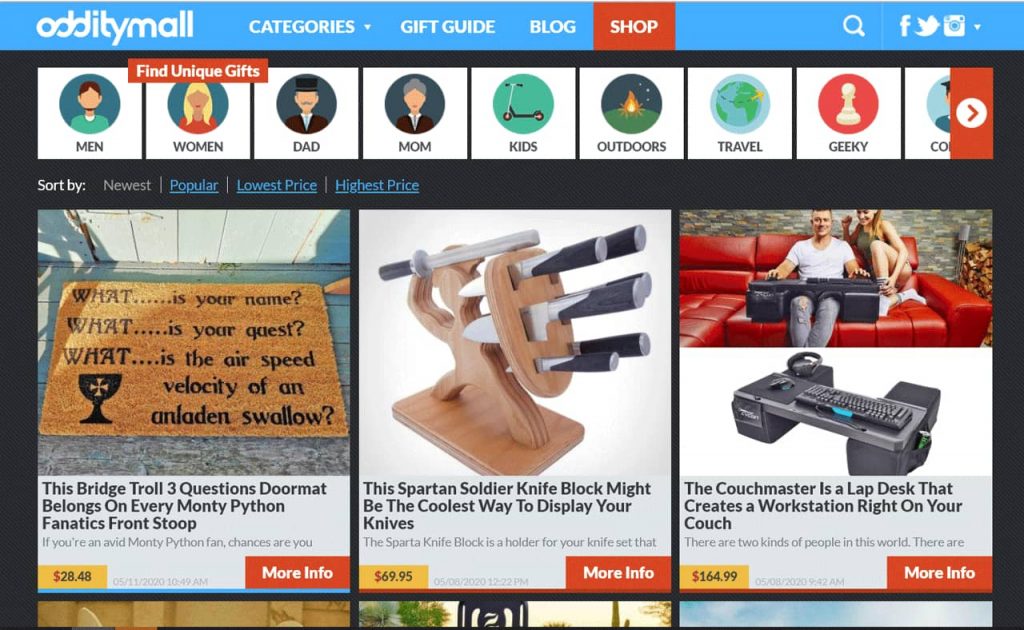
Oddity Mall’s odd-looking homepage.
Oddity Mall is an incredibly successful dropshipping store based around the product niche of quirky and bizarre gifts. If you’re wondering if there’s much of a market for that, just check out their Facebook fanbase.
Their catalogue is astounding in its depth. Over the 8 years that they’ve been in existence, they’ve sourced a frankly ridiculous amount of weird and wacky gift ideas and have been selling them on their Shopify-built site.
What they do well:
- They have an incredible niche with unlimited possibilities for merchandise.
- They have one of the largest catalogs of any dropshipping site and update new products daily.
- They have built a huge following on Facebook, with 2.8 million likes and a Facebook marketing strategy that contributes to over 85% of their revenue.
- Their well-written blogs and gift guides bring in a huge amount of organic traffic, many of which either buy at their store or click on their affiliate links to products on Amazon and AliExpress.
Free Facebook & Google Ads Account Audit
Get your ad accounts audited & find the opportunities you’ve missed out on with actionable tips from certified PPC experts.
Improve ROAS, CPC, CTR & increase sales with an easy-to-implement, step-by-step guide made JUST for your store.
3.2.Dog Pawty

Dog Pawty’s Instagram is full of followers and cute ambassadors.
It’s not hard to guess what Dog Pawty is selling. This accessory shop for dogs has done amazingly well to amass a following of 325,000 fans on Facebook, as well as 15,000 followers on Instagram.
Of course, what helps is that the company uses loveable dogs as their ambassadors. They encourage customers to post pictures of dogs wearing their products, which fosters an online following for the company that they accentuate with well-made dog blogs.
What they do well:
- They have a great online presence through using cute dog ambassadors.
- They garner organic traffic through a large back catalogue of blogs.
- They also sell dog-related clothing for owners, which is a clever way to expand their catalogue while still staying in-niche.
3.3. Aesthentials
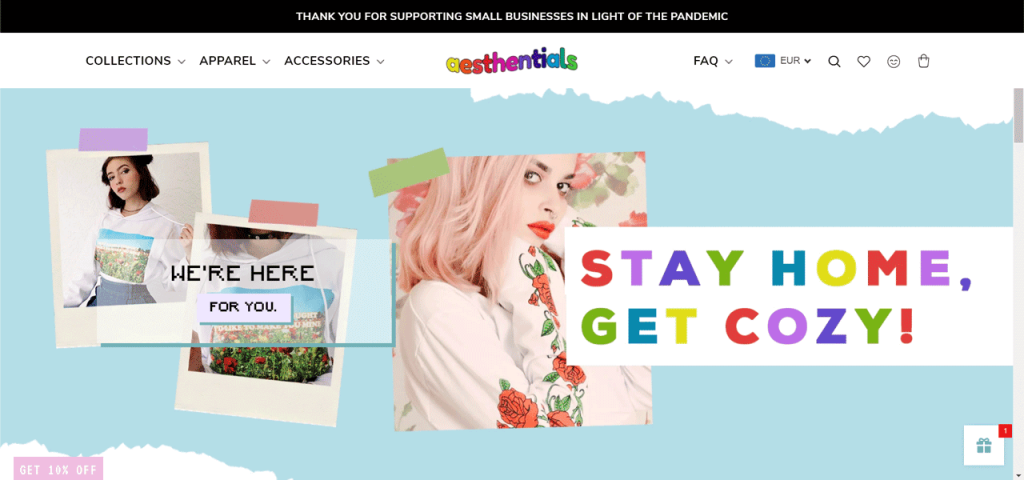
A stylish website design helped Aesthentials to build a high traffic Shopify dropshipping store.
Despite the hard-to-pronounce name, Aesthentials managed to carve out a good niche in a very un-niche market. There’s no shortage of clothes for teenagers out there, but Aesthentials is for teenagers who want to stand out.
Their website is full of great design features that appeal to their targeted young female audience. It’s also full of their own photography, which is rare for a dropshipping store, but gives them a strong sense of identity and of not being a business that relies on dropshipping wholesale products.
What they do well:
- Great website design, perfect for their target audience.
- Exclusive photography across every product they sell.
- Over 50% of their revenue is generated via YouTube campaigns where influencers popular with young teens market their products.
What to Take Away
Well there you have it – how to build a high conversion dropshipping store on Shopify in 10 easy steps.
Remember, dropshipping can be highly lucrative, but taking the time to research the process thoroughly is eventually going to be what makes you stand out from the crowd.
If you’re worried about costs stacking up, remember that dropshipping is highly affordable. It’s a model where small investments can result in incredible payouts. Still, you will have to be mindful of start-up costs before you make your first sale:
- ~ $29/month to subscribe to Shopify after your free trial ends.
- ~ $180 for a professional Shopify theme (free ones are available but very limited).
- ~ $30/month for a high-quality dropshipping app.
- ~ $10 – $100/month for additional Shopify apps like currency convertors, upsell apps, page builders like PageFly, etc.
You also have to consider the initial product test costs, which depend on the value of your product, as well as the costs of your marketing, which vary wildly between stores. This might seem a steep climb now, but when you’re at the top of the dropshipping hill looking down, these costs can seem minimal compared to your gains.
Regardless, following our 9 step process to dropshipping on Shopify is going to be what gets you results:
- Claim your free Shopify trial
- Download your dropshipping apps
- Import your products
- Building the perfect dropshipping store
- Setting up payments and dealing with customers
- Get advertising
- Create some blogs
- Create a domain name
- Make a ‘coming soon page’
All of these steps, along with the ‘what to do’ and ‘what not to do’ that we’ve featured above, is a surefire way to get your dropshipping store up, full of leads and full of conversions. Good luck!